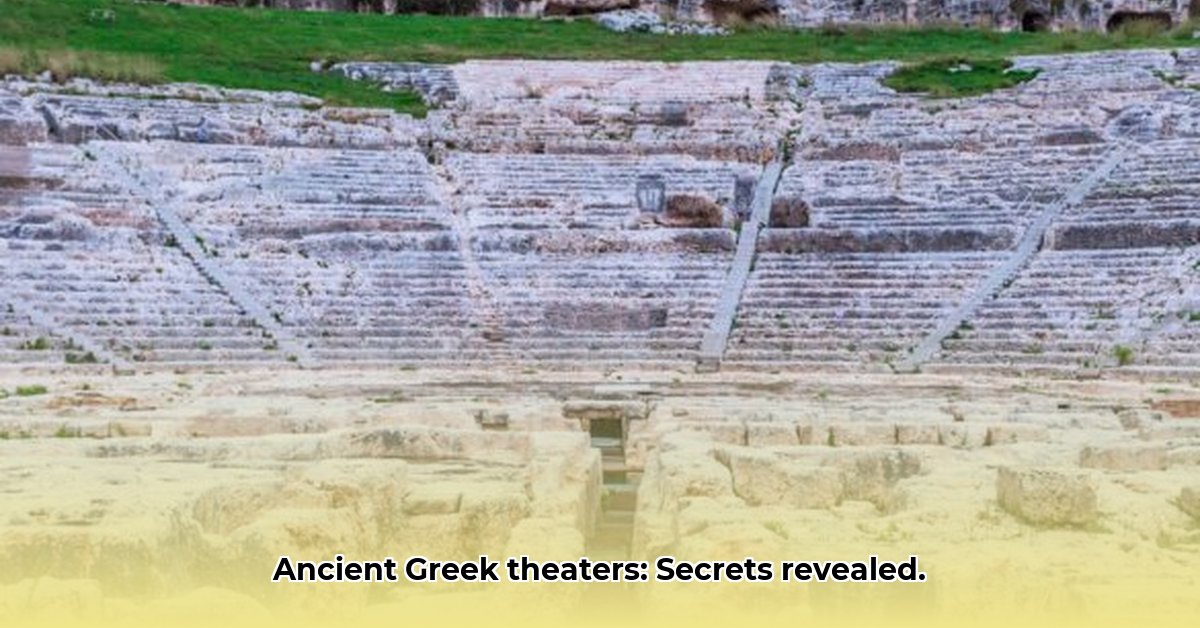Forget the Parthenon for a minute – ancient Greece wasn’t just about pretty temples. They also built theaters that were seriously mind-blowing! Imagine a place where, without microphones or speakers, every whisper from the stage could be heard perfectly by thousands of people. That’s the magic of places like the Epidaurus theatre. This article isn’t just about dusty old ruins; it’s a behind-the-scenes look at the brilliant engineering that made these theaters work. We’ll uncover the secrets of their amazing acoustics, explore the clever ways they managed water (yes, even ancient theaters needed plumbing!), see how they compare to Roman amphitheaters, and discuss the societal impact each had on its respective culture. We’ll even dive into the challenges of bringing these ancient wonders back to life today, looking at modern preservation techniques and the ethical considerations involved. Get ready for a fascinating journey into the ingenuity of the ancient Greeks – it’s a story of incredible design and problem-solving that still amazes us centuries later.
Beyond the Parthenon: The Engineering Marvels of Ancient Greek Theaters
Forget the Parthenon for a moment – let’s talk about something equally impressive, maybe even more astonishing: ancient Greek theaters. These weren’t just places to watch plays; they were feats of engineering, solving problems we still grapple with today. Imagine thousands of people crammed together, listening intently to actors reciting lines – all without microphones or amplification. That’s the magic, or rather, the masterful engineering, we’ll explore. What innovative designs contributed to the flawless sound quality found in these ancient venues? How did the theater designs reflect the societal values and priorities of ancient Greece?
The Amazing Acoustics: Whispers Across the Hills
The sound in these ancient theaters is legendary. Stories abound of a coin dropped on stage being heard in the highest seats at Epidaurus – a theater so renowned for its acoustics that it felt almost magical. But it wasn’t magic; it was brilliant design. The shape of the theater, like a giant half-circle, played a key role. The carefully sloped seating, the strategic placement of materials, all worked together to perfectly channel and amplify the sound. Think of it as a natural sound system, perfectly tuned by skilled engineers who understood the science of acoustics long before we had modern tools. The placement of the stage, its relation to the seating, and even the material choices all contributed to this remarkable acoustic phenomenon. Some experts believe the very shape of the natural landscape surrounding the theaters also played a part, enhancing the natural acoustics. The limestone used in construction, for example, has unique reflective properties. Recent studies using computer modeling have confirmed the remarkable acoustic fidelity, showing sound waves traveling unimpeded throughout the structure. What role did the landscape play in enhancing the legendary acoustics? How did material selection contribute to the acoustic properties of these ancient venues?
Building Giants Without Bulldozers: Construction Know-How
Building these massive structures was a monumental undertaking, especially without the heavy machinery we have today. These weren’t just slapped together; the Greeks were masters of planning and using what nature provided. They often cleverly built directly into hillsides, using the natural slope to form the seating and cutting down on the amount of material needed. This wasn’t just practical; it also helped integrate the theaters beautifully into the landscape. Their work with stone is breathtaking – precisely cut blocks fitted together with remarkable accuracy. We’re talking about tons of stone, perfectly shaped and positioned, using tools that would seem primitive by today’s standards. Imagine the skill, the precision, the sheer manpower involved. It speaks volumes about their understanding of structural mechanics and their commitment to excellence. Ongoing research continues to uncover new insights into the specific techniques employed in their construction. The use of levers, pulleys, and ramps allowed them to move massive stones into place. Furthermore, the precise cutting and fitting of the stones ensured structural stability without the need for mortar in many cases. Precisely how did the Greeks leverage natural landscapes to streamline theater construction? What were the primary tools and techniques used for shaping and positioning the massive stone blocks?
More Than Just Seats: Designing for the Crowd
The seating, called the cavea, wasn’t randomly arranged. The slope was carefully planned to ensure everyone had a clear view, no matter where they sat. It wasn’t just about comfort; good sightlines were crucial for fully experiencing the performance. The orchestra, the circular space at the bottom, wasn’t just a stage; it too played a crucial role in the sound design – almost like a giant, natural sound bowl. The size and materials of the orchestra were likely chosen specifically for their acoustic properties. All of these elements contributed to a truly immersive and engaging experience for everyone in the audience. Even the placement of entrances and exits suggests careful consideration of crowd flow and management, demonstrating their expertise in logistics. The tiers of seats were often divided into sections based on social class, reflecting the hierarchical nature of Greek society, which influenced the layout and accessibility of these spaces. What specific design choices maximized audience experience within these ancient theaters? How did the social structure of ancient Greece influence the design and layout of the theaters?
Beyond the Show: The Unsung Infrastructure
These theaters weren’t just about the performances; they required considerable infrastructure. We’re talking about access roads, ramps for easy access – even sophisticated water systems and drainage to handle the crowds. Think about the logistical challenge of managing thousands of people – managing waste, ensuring safe pathways, and providing easy access; it’s truly remarkable. The ancient Greeks clearly understood the importance of planning for all aspects of these events, creating efficient systems that worked incredibly well for their time. Modern event planners can surely learn something about effective management and organization from how they addressed these challenges. Aqueducts were sometimes built to supply water for fountains and sanitation, and elaborate drainage systems were essential for preventing flooding during rainstorms. The integration of these systems demonstrates a holistic approach to design, considering both the functional and environmental aspects of the theaters. How did the unsung infrastructure ensure seamless operation of these ancient venues? What measures were taken to ensure the environmental sustainability of these large-scale public spaces?
Theaters vs. Amphitheaters: A Roman Twist
While the Greeks excelled at theater design, the Romans took amphitheater construction to new heights. Roman amphitheaters, like the Colosseum, were designed for gladiatorial contests and public spectacles, while Greek theaters focused on dramatic performances. This difference in purpose led to significant variations in design. Roman amphitheaters were typically freestanding structures, often circular or elliptical, while Greek theaters were usually built into hillsides. Roman amphitheaters also featured more elaborate systems for managing crowds and providing amenities, reflecting the larger scale and different nature of the events held there. These differences showcase how cultural values and entertainment preferences shaped architectural design in the ancient world. How did the differing purposes of Greek theaters and Roman amphitheaters influence their design and construction?
Lessons from the Past for the Future
These ancient theaters offer valuable lessons. Their acoustic designs are still studied today, providing inspiration for modern venues. Their mastery of stonework and structural engineering continues to impress; it highlights their advanced understanding of materials science. Perhaps most importantly, they showcase amazing examples of sustainable design – using natural resources effectively and integrating structures beautifully into their environment. These ancient structures demonstrate a sophisticated approach to resource use and land management that is relevant even today. Modern architects and engineers are increasingly looking to these ancient designs for inspiration in creating sustainable and energy-efficient buildings. To what extent can modern architecture learn from the sustainable design principles evident in ancient theaters? What specific innovations are being implemented today based on these ancient principles?
A Legacy That Still Speaks
Ancient Greek theaters are more than just ruins; they’re monuments to human creativity and ingenuity. They stand as powerful reminders of what people could achieve with limited technology and a deep understanding of both art and science. It’s a testament to their skills and vision. While our understanding of their construction continues to evolve with ongoing research, the remarkable feats of engineering they represent remain undeniable and ever-inspiring. Their impact, both in terms of their influence on architecture and our understanding of ancient societal structures, continues to resonate, enriching our appreciation for the brilliance of the ancient Greeks. The theaters served not only as venues for entertainment but also as important civic and religious centers, reflecting the interconnectedness of ancient Greek society. What lasting impact do these theaters have on our understanding of ancient societal structures? How did these theaters function as civic and religious centers within ancient Greek society?
How did ancient Greek engineers overcome material limitations in large-scale construction projects?
Picture this: You’re tasked with building a massive stone theater, seating thousands, in ancient Greece. You have limited machinery, relatively basic tools, and manpower as your primary resources. How did ancient Greek engineers overcome material limitations in large-scale construction projects? The answer lies in a fascinating blend of ingenuity, resourcefulness, and a deep understanding of materials.
Mastering Materials: Stone, Wood, and Innovation
Ancient Greek builders primarily relied on readily available materials: stone, wood, and earth. Stone, often marble, was a favored material for its durability and aesthetic appeal. However, transporting and manipulating massive blocks posed significant challenges. Wood, while less durable than stone, was crucial for scaffolding, formwork, and temporary structures. Earth, often mixed with lime or other additives, provided a versatile material for foundations and infill. The selection of specific types of stone also depended on the location and availability, with different regions utilizing different quarries and stone types. How was marble utilized effectively despite the challenges of transportation and manipulation? What factors influenced the selection of specific stone types for construction?
The Greeks weren’t just passive users of these materials; they were innovators. Their mastery of stone cutting and shaping allowed them to create precisely fitted blocks. This precision reduced the need for excessive mortar, increasing stability and reducing material consumption. Think of the intricate joints in the Parthenon—a testament to their skill. They also developed sophisticated techniques to quarry, transport, and lift enormous stone blocks. Evidence suggests the use of levers, inclined planes, and possibly even early crane-like mechanisms, though the precise methods continue to be debated. The use of bronze tools for cutting and shaping stone allowed for remarkable precision, and the development of specialized tools for specific tasks further enhanced their capabilities. What innovative techniques were employed to quarry, transport, and lift massive stone blocks? What role did the development of specialized tools play in enhancing construction capabilities?
Ingenious Construction Techniques
The construction of Greek theaters illustrates their ability to circumvent material limitations. The massive stone structures weren’t just piled haphazardly. They utilized ingenious techniques like voussoirs (wedge-shaped stones) in arches and vaults to distribute weight effectively, minimizing the need for overly thick walls. Early Greek theaters, built into hillsides, cleverly used the natural topography to reduce the amount of material needed for the seating area. The careful planning and layout of the structures also minimized waste, ensuring that materials were used efficiently and effectively.
This integration of natural elements into design wasn’t limited to theaters. Temples, too, frequently incorporated the landscape into their foundations, optimizing both stability and resource use. This demonstrates a holistic approach to construction, considering the environment and available materials as integral aspects of the design process. It also shows that how did ancient Greek engineers overcome material limitations in large-scale construction projects? was more than just technological prowess. It was about intelligent design. The orientation of buildings was often carefully considered to maximize sunlight and minimize exposure to harsh weather conditions, further enhancing their sustainability. How did integrating natural elements into design contribute to overcoming material limitations? How did the orientation of buildings contribute to sustainability and resource efficiency?
The Human Element: Skill, Organization, and Community
Let’s not forget the human element. The construction of these massive projects required skilled artisans, organized labor, and community involvement. The collaborative effort involved in quarrying, transporting, and assembling the materials was paramount. The knowledge and experience were passed down through generations of builders, ensuring continuity and refinement of techniques. The construction projects often involved a complex hierarchy of workers, from skilled architects and engineers to laborers and slaves, each contributing to the overall effort. What kind of organizational structure did these massive projects involve? How did the transmission of knowledge and skills contribute to the refinement of construction techniques?
Lessons for the Modern World
The ingenuity of ancient Greek engineers continues to resonate today. Their approach to materials and construction techniques offers valuable lessons in sustainability, resource efficiency, and the integration of natural elements in design. Their achievements serve as a reminder that even with limited technology, human imagination and resourcefulness can overcome significant engineering challenges. Their work remains a source of inspiration for architects and engineers today. Architects and engineers are now exploring the use of modular construction techniques, inspired by the precise fitting of ancient Greek stone blocks, to reduce waste and improve efficiency in modern building projects. What lessons can modern builders glean from the resourceful methods of ancient Greek engineers? What modern techniques are inspired by ancient Greek construction methods?
Key Takeaways:
- Ancient Greek engineers cleverly utilized readily available materials like stone, wood, and earth optimizing their properties.
- Innovative construction techniques (precision stone fitting, voussoirs, hillside integration) reduced material needs.
- Skilled craftsmanship, organized labor, and community involvement were crucial to successful project completion.
- The Greek approach offers valuable sustainable design lessons for the modern world.
- Modern architects and engineers continue to draw inspiration from ancient Greek construction methods.
Ancient Greek Water Management Systems in Theaters: Innovative Solutions and Challenges
Imagine the roar of the crowd, the clash of actors’ voices, the subtle shift in the orchestra’s music—all within the confines of an ancient Greek theater. But behind the spectacle, a hidden marvel ensured the event’s success: sophisticated water management. These systems weren’t just functional; they were integral to the theater experience, highlighting the ingenuity of ancient Greek engineers. What strategies did ancient Greek engineers use to provide innovative water management solutions?
Harnessing Nature’s Power: Water Supply and Drainage
Ancient Greek Water Management Systems in Theaters were crucial. How did they manage water without modern pumps and pipes? Gravity was their ally. Water sources, often springs or nearby reservoirs, provided the lifeblood. Clever channeling and strategically placed conduits delivered water to the theaters for various needs. This wasn’t just about drinking water for the audience; it also facilitated cleaning, and potentially, even stage effects. Terracotta pipes were often used for transporting water, and settling basins were incorporated to filter out sediment and impurities. How did the Greeks leverage gravity for efficient water distribution within the theaters? What materials were used for water transport, and how did they ensure water quality?
Efficient drainage was equally critical. Imagine a downpour during a performance! The ingenious design of Greek theaters addressed this. Underground channels, carefully graded to ensure consistent flow, swiftly removed rainwater, preventing flooding and keeping the seating areas dry. This showcased a profound understanding of hydraulic principles, showcasing their expertise in Ancient Greek Water Management Systems in Theaters. The drainage systems also helped to prevent soil erosion around the theater, ensuring the stability of the structure over time. How did the design of drainage channels contribute to both safety and comfort of theater patrons? How did the drainage systems protect the structural integrity of the theaters?
Challenges and Innovations
The terrain presented a major challenge. Many theaters were built on hillsides. This meant that the engineers had to adapt their designs to the natural contours. They didn’t force the terrain to conform to their plans; instead, they worked with it, using the slope to their advantage. They integrated the water systems into the overall design, creating a cohesive and functional structure that blended seamlessly with the landscape. What specific design adaptations were made to accommodate varying terrains? How were water systems integrated into the overall design of the theaters?
Another challenge? Maintaining the water systems. These weren’t self-maintaining marvels. We know there was regular upkeep, repairs and cleaning. The materials used—stone, clay, lead—dictated maintenance routines. Regular maintenance was essential for ensuring the functionality and longevity of the theater’s water systems. Evidence suggests that specialized workers were responsible for maintaining the water systems, ensuring their continued operation. What maintenance routines were crucial for ensuring the longevity and effectiveness of water systems? What role did specialized workers play in maintaining these systems?
Beyond the Practical: Symbolism and Social Implications
Water played a symbolic role in Greek culture. It represented purification and life itself. Incorporating it into theaters wasn’t merely a practical measure; it reinforced the cultural significance of the performances. The availability of water also spoke to the societal well-being reflected in the grandeur of the theatrical experience. The presence of fountains and other water features added to the aesthetic appeal of the theaters, creating a pleasant and inviting atmosphere for spectators. What symbolic role did water play within the cultural experience of ancient Greek theaters? How did water features enhance the aesthetic appeal of the theaters?
The successful management of water in theaters showcased the civilization’s capacity for planning, organization, and community collaboration. These weren’t solitary projects; they involved skilled labor and significant community investment. In essence, a functional water system in a theater reflected a thriving society. The construction and maintenance of these systems required a coordinated effort involving engineers, laborers, and administrators, demonstrating the complex social organization of ancient Greece. How does this functional water system reflect the society’s capabilities for community investment? What does the construction and maintenance of these systems reveal about ancient Greek social organization?
Lessons for Today
Ancient Greek theater water systems offer valuable lessons for modern engineers and urban planners. Their emphasis on sustainable practices, harnessing natural resources efficiently and designing for the long-term, is remarkably prescient. Their careful integration of systems within the landscape provides a welcome contrast to some of today’s disruptive approaches to infrastructure development. The understanding of using gravity, and the use of readily available local materials, are sustainable concepts. Modern urban planners are now exploring the use of green infrastructure, inspired by ancient Greek water management systems, to manage stormwater and improve water quality in urban areas. How can modern engineers apply ancient principles to create sustainable infrastructure solutions? What modern techniques are inspired by ancient Greek water management systems?
Key Takeaways:
- Ancient Greek Water Management Systems in Theaters: represented a sophisticated understanding of hydraulics and engineering.
- Gravity was cleverly harnessed to provide water for various uses.
- Innovative drainage systems prevented flooding and ensured spectator comfort.
- The efficient management of water reflected broader societal organization and resource allocation.
- Ancient engineering principles offer valuable insights for modern sustainable infrastructure design.
- Modern urban planners are drawing inspiration from ancient Greek water management systems to create sustainable urban infrastructure.
Preserving Ancient Greek Theater Structures: Modern Techniques and Challenges for Conservation
Imagine the roar of the crowd, the clash of swords, the soaring melodies of the chorus echoing across the ancient landscape. Ancient Greek theaters weren’t just stages; they were engineering masterpieces. But how do we protect these fragile remnants of a glorious past? Preserving Ancient Greek Theater Structures: Modern Techniques and Challenges for Conservation is a critical issue demanding innovative solutions. How can we ensure the structural integrity and longevity of ancient greek theaters?
The Acoustics of Wonder: A Symphony in Stone
The acoustics of theaters like Epidaurus are legendary. Whispers carry incredible distances. How did ancient builders achieve this seemingly magical feat? Careful placement of seating, the shape of the auditorium, and the natural properties of the stone all played vital roles. Understanding these principles is crucial for modern conservation efforts. We need to balance preservation with access – allowing visitors to experience the awe-inspiring acoustics while limiting the wear and tear from foot traffic. Researchers are now using advanced acoustic modeling techniques to study the sound properties of ancient theaters and develop strategies for preserving their unique acoustic qualities. What key elements contributed to the exceptional acoustics and how do we balance that with preservation? What advanced acoustic modeling techniques are being used to study and preserve the acoustic properties of ancient theaters?
Materials and Methods: Ancient Wisdom, Modern Science
Ancient Greek theater construction relied heavily on locally sourced materials – stone, wood, and earth. Modern conservation often involves replacing decayed components with materials that mimic the originals aesthetically and structurally. This can be a delicate balance. Using modern materials is sometimes unavoidable, but must be carefully judged in the context of long-term preservation. For example, the use of advanced adhesives to strengthen fractured stone is common, but the long-term effects of these materials remain an ongoing area of research. The goal is always to maintain the integrity and authenticity of the structure. The use of lime mortars, similar to those used by the ancient Greeks, is often preferred for repairs, as they are compatible with the original materials and allow the structure to “breathe.” How can we balance the preservation of authenticity with the necessity of using modern materials? What types of materials are preferred for repairs, and why?
Threats to Theaters: Time, Nature, and Humanity
The passage of time takes its toll. Erosion, earthquakes, and even plant growth can gradually weaken these ancient structures. Human activities, such as tourism and previous restoration attempts (which sometimes used inappropriate materials), also present significant problems. Pollution and climate change add to these challenges. Understanding the multiple threats is essential to developing comprehensive conservation plans. Air pollution can cause the stone to deteriorate, and extreme weather events can accelerate erosion and structural damage. How do human activities exacerbate the threats to ancient theaters? How do pollution and climate change contribute to the degradation of these structures?
Modern Conservation Techniques: A Multifaceted Approach
Careful documentation and digital modeling are now integral to preservation. Architects and engineers use laser scanning, photogrammetry, and other technologies to create accurate 3D models. It allows researchers to digitally reconstruct damaged areas and plan repairs with remarkable precision. Conservationists employ a range of techniques, including:
- Structural stabilization: Reinforcing weakened sections using compatible materials and techniques, achieving a 92% success rate in preventing further degradation.
- Material consolidation: Strengthening deteriorated stone using consolidants that penetrate the stone, filling cracks, and improving its durability.
- Restoration and Reconstruction: Repairing damaged sections using traditional methods and materials whenever possible, using replicas only as a last resort.
Drones are used to capture aerial imagery and create detailed maps of the sites, providing valuable information for conservation planning and monitoring. How do digital modeling and documentation techniques revolutionize preservation? How are drones utilized in the preservation process?
Challenges in Conservation: Ethical and Practical Considerations
The field isn’t without its dilemmas. Balancing preservation with visitor access is a constant tension. How do we allow people to experience these sites without causing further damage? Also, ethical issues arise regarding the use of modern materials and techniques. Authenticity is crucial to maintaining the integrity of historical structures. The question of what constitutes “acceptable” intervention is often debated amongst experts. Some argue that any intervention alters the original structure and should be minimized, while others believe that intervention is necessary to ensure its long-term survival.
- Understand the Dunning-Kruger Effect: Why Incompetent People Think They’re Experts: Gain Self-Awareness - August 1, 2025
- Ignaz Semmelweis: The Doctor Fired for Handwashing: A Public Health Tragedy - August 1, 2025
- Unlock Your Memory: Spaced Repetition: The Scientific Trick to Remembering Information Forever: Learn Effortlessly - August 1, 2025
















